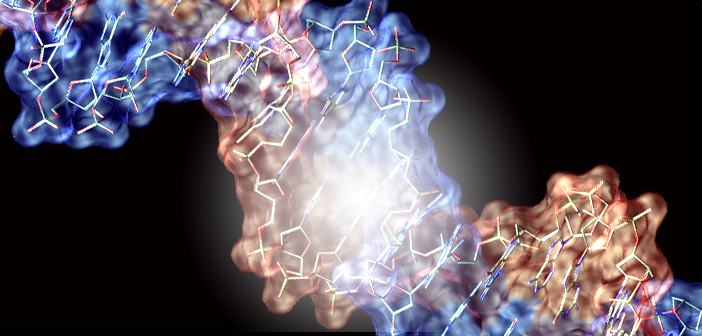image: 1
Scientist Dr. Lipton: Human beings are not controlled by DNA but we can select genes. – It is essentially important to raise vibrations of Sattva (awareness).
I find this article to be very interesting.
I agree with this theory. My understanding is that gene activation depends on
the consciousness of an individual. According to the article, “it is actually
our beliefs that select our genes, that select our behavior.” However, belief
and mind are originally one and it connects to consciousness. I think that
consciousness determines to turn DNA on or off.
Although many people think that awareness,
mind and belief are the same, they are different in energy state. Indian philosophy
has a concept of Guna: It is divided
into sattva (serenity), rajas (passion) and tamas (ignorance). These three are originally one but have
different attributes.
Awareness corresponds to sattva, mind to rajas and belief (idea) to tamas.
There is “positive thinking.” It seeks to raise awareness by improving a state
of tamas and as a result changing
mind. It is a very complicated way.
Visualization directly works on mind and
promotes to change the current situation. Although it is creativity, rajas (passion) inherently causes
suffering. Tamas (ignorance) is
inertia.
As a matter of fact, you had better not get
involved in these two gunas. Sattva (purity) is lightness and
brightness. It would safe to say that sattva
is “awareness” in easy-to-understand words. It is essentially important to
raise vibrations of sattva, that is
to say, awareness, which leads to curbing rajas
and tamas.
What should we do, then? We are given the
most powerful mantra Gayatri Mantra.
December
11, 2015
Masatoshi
Takeshita
Excerpt from a Japanese article: Epoch Times in Japan - November 13, 2015 –
Scientist
Mr. Lipton: Human beings are not controlled by DNA but we can select genes.
The common idea that DNA determines
so much of who we are—not only our eye or hair color, for example, but also our
addictions, disorders, or susceptibility to cancer—is a misconception, said stem-cell
biologist Bruce Lipton, Ph.D.
“You
find yourself to be more or less a victim of your heredity,” Lipton said in the
documentary Biology of Belief. “The problem with that belief system is
that it extends to another level. … You become irresponsible. [You say,] ‘I
can’t do anything about it, so why try?’”
This
concept “says you are less powerful than your genes,” Lipton explained.
He
said a person’s perception, not genetic programming, is what
spurs all action in the body: “It’s actually our beliefs that
select our genes, that select our behavior.”
The
following is a simplistic summary of Lipton’s understanding. For more details,
you can watch his documentary below.
5-Step Explanation
1. The cell is like a
human body and it functions without DNA
The cell
is like a human body. It is capable of respiration, digestion, reproduction,
and other life functions. The nucleus, which contains the genes, has
traditionally been viewed as the control center—the brain of the cell.
Yet, when the
nucleus is removed, the cell
continues with its life functions for a month or more and it can still
recognize toxins and
nutrients. It appears the nucleus—and
the DNA it
contains—does not control the cell.
Scientists
assumed some 50 years ago that genes control biology. “It just seemed so
correct, we bought the story,” Lipton said. “We don’t have the right
assumptions.”
2. DNA is controlled
by the environment
Proteins
carry out the functions in cells and they are building blocks of life. It has
long been thought that DNA controls
or determines the actions of proteins.
Lipton
proposes a different model. Environmental stimuli that come into contact with
the cell membrane are perceived by receptor proteins in the membrane. This sets
off a chain reaction of proteins passing on what could be described as messages
to other proteins, motivating action in the cell.
DNA is
coated in a protective sleeve of protein. The
environmental signals act on that protein, causing
it to open up and to select certain genes for use—genes specifically
needed to react to the current environment.
Basically, DNA
is not the beginning of the chain reaction. Instead,
the cell membrane’s perception of the environment is the first step.
If there
are no perceptions, the DNA is
inactive.
“Genes
can’t turn themselves on or off … they can’t control themselves,”
Lipton said. If a cell is cut off from any environmental stimuli, it doesn’t do
anything. “Life is due to how the cell responds to the environment.”
3. Perception of the
environment is not necessarily the reality of the environment
Lipton
cited a 1988 study by John Cairns published in the journal Nature titled “The
Origin of Mutants.” Cairns
showed that mutations in DNA were not random, but happened in a
predetermined way in response to environmental stresses.
“In every
one of your cells, you have genes whose function it is to rewrite and adapt
genes as necessary,” Lipton explained. In a chart illustrating
Cairns findings in the journal, environmental signals were shown to be separate
from the organism’s perception of environmental signals.
A
being’s perception of the environment acts as a filter between the reality of
the environment and the biological reaction to it.
“Perception
rewrites genes,” Lipton said.
4. Human beliefs,
choosing to perceive a positive or negative environment
Just as a
cell has receptor proteins to perceive the environment outside the cell
membrane, humans have the five senses.
These are
what help a person determine which genes need to be activated for a given
situation.
The
genes are like programs on a computer disk, Lipton said. These programs can be
divided into two classes: the first relates to growth, or reproduction; the
second relates to protection.
When
a cell encounters nutrients, the growth genes are activated and used. When a
cell encounters toxins, the
protection genes are activated and used.
When a
human being encounters love, the
growth genes are activated. When a
human being encounters fear, the
protection genes are activated.
A
person may perceive a negative environment where there is actually a supportive
or positive environment. When this negative perception activates
the protection genes, the body’s response is to go into fight-or-flight mode.
5. Fight or flight
Blood
flow is directed away from the vital organs to the limbs, which are used for
fighting and running. So, when a person perceives a negative
environment, the body tends to neglect the immune system and vital organs.
Stress also makes us less intelligent, less clear-minded. The part of the brain
related to reflexes is given more prominence in fight-or-flight mode than the
part related to memory and other mental functions.
When a
person perceives a loving environment, the body activates growth genes and
nurtures the body.
Lipton
gave the example of Eastern European orphanages, where children are given
lots of nutrients, but little love. Children in such institutions have been
found to have stunted development in terms of height, learning, and other
areas. There is also a high incidence of autism.
Lipton said autism in this case is a symptom of protection genes
being activated, like walls being put up.
“Beliefs
act as a filter between the real environment and your biology,” he said. Thus,
people have the power to change their biology. It is
important to keep a clear perception, he said, because otherwise you won’t
develop the right things biologically for the real environment around you.
“You
are not victims of genes,” he said, asking the audience to consider “What
beliefs are you selecting genes with?”

